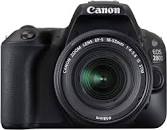Auto Shooting
All amateur photographers begin to master their first camera from shooting in auto mode. Moreover, even some professionals like to give the shooting parameters at the mercy of the camera’s intellect and go headlong into the frame, forgetting about the annoying shutter speed and aperture figures.Canon EOS 200D / Canon EF-S 10-18mm f / 4.5-5.6 IS STM Settings: ISO 100, F5.6, 1/50 s, 10.0 mm equiv.Download RAW
All this once again confirms the importance of the accurate operation of the automatic shooting mode in modern cameras. Let's see what the Canon EOS 200D boasts here .
When you turn it on for the first time, after setting the time and date, the unusual interface of the camera is immediately evident. Its appearance may surprise even photographers who have long been familiar with the Canon system. In the new cameras of amateur rulers, the company changed the “classic” interface with an abundance of digits incomprehensible to a beginner to a more friendly one.
Its task is to show “on the fingers” what happens to the picture when the shutter speed or aperture changes. Finger icons are small icons. We spin the wheel and choose what is more important for us: a blurred or clear background.
Simple, clear, understandable, but a little confused is the strong abbreviation of terms that can sometimes be found on the screen.
An experienced photographer, of course, will understand what this is about ...
... but for a beginner, such reductions can be a mystery.
But the matter was not limited to one interface change. To help those who are just starting to master their camera, the Canon Photo Companion application is designed.
Canon EOS 200D / Canon EF-S 35mm f / 2.8 Macro IS STM Settings: ISO 100, F5.6, 1/125 s, 35.0 mm equiv.Download RAW
But let's finally move on to shooting. To test the intelligence of the camera, I intentionally forget about the Av, Tv, P, and M modes. I set the “green” mode, and the camera tells me that this is an “intelligent scene definition”.
Canon EOS 200D / Canon EF-S 10-18mm f / 4.5-5.6 IS STM Settings: ISO 640, F5.6, 1/40 s, 10.0 mm equiv.
It differs from primitive automation by the logic of work. Canon EOS 200D will try to identify each scene and, depending on the plot, select certain shooting parameters.
Canon EOS 200D / Canon EF-S 18-135mm f / 3.5-5.6 IS STM Settings: ISO 100, F5.6, 1/500 s, 100.0 mm equiv.Download RAW
It sounds complicated, but in practice everything is much simpler. When we “aim” for a portrait, the camera detects the face in the frame, focuses on it and opens the aperture to blur the background.
Canon EOS 200D / Canon EF 70-200mm f / 4L IS Settings: ISO 200, F4, 1/1000 s, 127.0 mm equiv.Download RAW
If there is action in the frame, the camera will recognize this and will try to use a faster shutter speed to avoid blurry objects.
But sometimes, when shooting a city landscape, automation aggressively tried to activate the built-in flash. It’s good that you can force it to be turned off, and a smart camera will warn you about the possible consequences.
If necessary, you can “tell” the camera what exactly you plan to photograph. In the "Special Scene" mode, several presets with the most common plots are available.
In this case, the operation of the automation will be adjusted, and the shooting parameters will be selected even more accurately.


